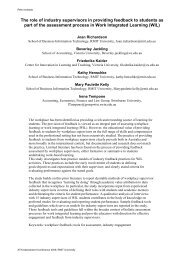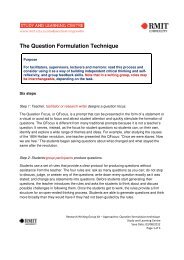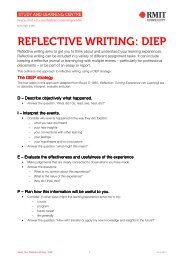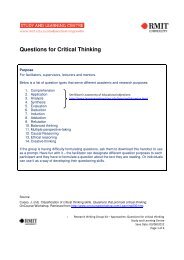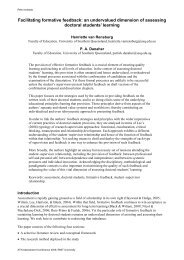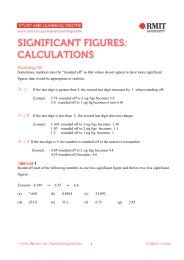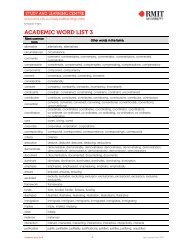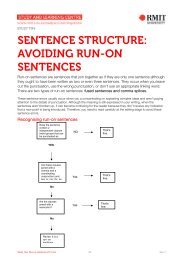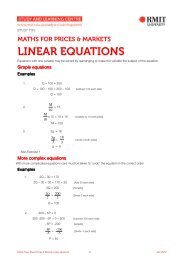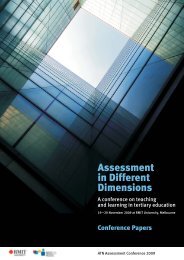student feedback and leadership - Office for Learning and Teaching
student feedback and leadership - Office for Learning and Teaching
student feedback and leadership - Office for Learning and Teaching
You also want an ePaper? Increase the reach of your titles
YUMPU automatically turns print PDFs into web optimized ePapers that Google loves.
Part A: Developing a Distributed Leadership Model - Secton 3: Building Leadership Capacity<br />
may be seen as academics ‘following’ <strong>student</strong> needs, on the other h<strong>and</strong>,<br />
it provided a solid base upon which ART members could explore ways<br />
in which they may lead improvement in the <strong>student</strong> learning experience.<br />
The initial attention of ART members was more focussed on the need <strong>for</strong><br />
infrastructure <strong>and</strong> systems improvement rather than improvements<br />
to teaching practice such as:<br />
1. the support of a consistent systems approach to enable data on <strong>student</strong><br />
<strong>feedback</strong> to be compared. This requires data to be disaggregated<br />
sufficiently to provide useful <strong>feedback</strong>. For example, in the SET service<br />
course data on <strong>student</strong> <strong>feedback</strong> from large classes with a mix of<br />
<strong>student</strong>s from different disciplines, needed to be disaggregated into<br />
<strong>student</strong>-discipline groupings.<br />
2. the need to encourage <strong>student</strong>s (especially first year <strong>student</strong>s) to accept<br />
responsibility <strong>for</strong> developing <strong>leadership</strong> in their own learning.<br />
3. the need to maintain a balance in the School between financial returns<br />
(increase with large classes) <strong>and</strong> resources available <strong>for</strong> quality learning<br />
<strong>and</strong> teaching.<br />
An interesting observation made by the Facilitators was the approach<br />
taken by the members of each ART members that followed their disciplinary<br />
expertise. The Maths <strong>and</strong> Geospatial ART members commenced their planning<br />
phase by using their mathematical skills to analyse the CES data, the Business<br />
ART sought to establish a Benchmarking process typical of Business, while<br />
the Property <strong>and</strong> Construction ART members used their construction expertise<br />
to focus on teaching spaces. As will be demonstrated later, the issue<br />
of disciplinary influence on <strong>leadership</strong> behaviour <strong>and</strong> approach in responding<br />
to <strong>student</strong> <strong>feedback</strong> became important again in Cycle 3 as a challenge <strong>for</strong><br />
disseminating ideas <strong>for</strong> improving <strong>student</strong> <strong>feedback</strong> between disciplines<br />
became evident.<br />
An observation made by the ARTs was the need to ensure that <strong>student</strong><br />
<strong>feedback</strong> is collected in an appropriate <strong>for</strong>m <strong>and</strong> in a manner that does not<br />
lead to <strong>student</strong>s feeling they are being over-surveyed as this in itself could<br />
have negative effects on their <strong>feedback</strong>.<br />
3.1.5 Reflect<br />
Reflection on the implications of action in this cycle <strong>for</strong> <strong>leadership</strong><br />
in enhancing <strong>student</strong> learning <strong>and</strong> teaching through responding to <strong>student</strong><br />
<strong>feedback</strong> identified the importance of an integrated approach in which topdown<br />
policy action is supported by bottom-up implementation. This led<br />
the Project Manager to articulate a theoretical model of <strong>leadership</strong> in which<br />
<strong>leadership</strong> is defined as a consequence of the actions of others, as distributed<br />
throughout the organisation with some staff taking <strong>leadership</strong> in relation<br />
to specific aspects of their work or interest <strong>and</strong> not in relation to others,<br />
<strong>and</strong> as supported by systems <strong>and</strong> infrastructure. Two of these factors<br />
were demonstrated in this cycle with the third emerging as an issue<br />
that was taken up in the second cycle.<br />
Page 41



